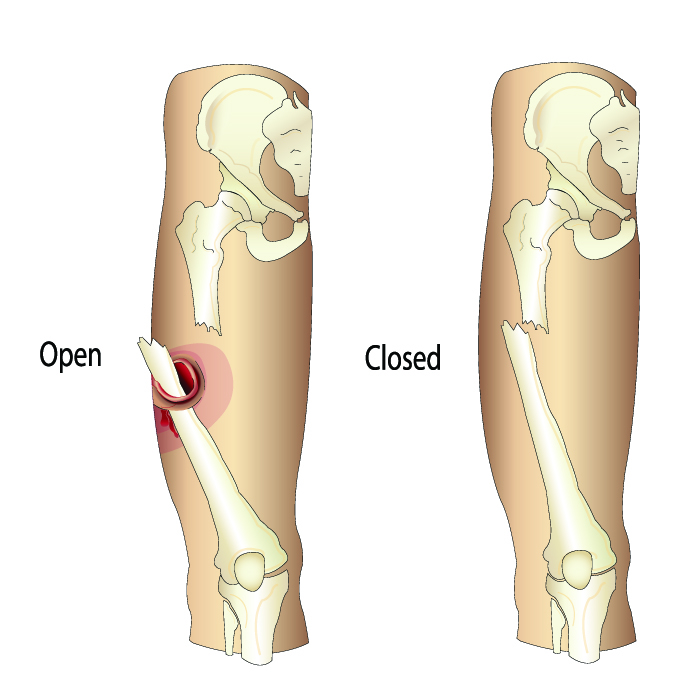Management of Open Fractures Treatment in Koramangala, Bangalore
An open fracture is a fracture in which there is a break in the skin or an open wound through which the fractured bone communicates directly with the extracorporeal world. It is a true orthopedic emergency due to the high incidence of infection that potentially leads to amputation and death.
For this surgery, most patients “go to sleep completely” and require a treatment method that is different from that used for closed fractures.
If a surgeon feels that you need an "open" surgery to fix the issue, then he or she may do it at the same time as your arthroscopic surgery. You must decide on this after consultation with your arthroscopy surgeon in Bangalore.

What do we need to know about arthroscopy?
Arthroscopy is a minimally invasive surgery performed on a joint during which an arthroscope or an endoscope is inserted into the joint through a slight incision. This is used to treat the damaged soft tissues.
Arthroscopic procedures can be used during ACL reconstruction, commonly used to treat meniscal (pertains to meniscus or the rubbery cartilage near thigh bone) injuries to the knee or any other injury. Depending on the level of invasiveness, most require only two small incisions, one for the arthroscope and the other for the surgical instruments that give a high definition 360-degree view of the injured area.
This helps in quickly identifying the problems and performing surgery that reduces recovery time and may increase the overall rate of success, while causing less trauma to the connective tissues.
You can consult an arthroscopy surgeon in Bangalore.
What are the types of open fractures?
The Guistillo and Anderson classification system is mostly used, it divides open fracture into three parts:
- Type 1: open fracture with clean wound less than 1 cm long
- Type 2: open fracture with laceration over 1 cm long, usually up to 10 cm, with extensive soft tissue damage, flaps or avulsion
- Type 3: open segment fracture, with extensive soft tissue damage and traumatic amputation. This requires adequate emergency debridement of the devitalized tissue
- Special category: open fracture with gunshot injury wound or vascular injury which needs repairs
What are the symptoms?
The symptoms of an open fracture include:
- Bone protruding from the skin
- Pain in the area gets worse when you move
- Bone deformity
- Loss of function in the injured area
What are the causes of open fractures?
Most open fractures are caused by:
- High-energy events, such as gunshot or vehicle accidents
- Lower-energy incidents, like injuries while playing sports
- A direct blow, like being struck by a heavy object
When do you need to see a doctor?
Open fractures are severe, so immediately seek medical treatment.
You can go for an arthroscopy-assisted treatment method which has been used successfully for the management of open fractures. Search online for an ortho hospital near me.
You can also request an appointment at Apollo Spectra Hospitals, Koramangala, Bangalore.
Call 1860 500 2244 to book an appointment.
What are complications of open fractures?
In case of open fractures, if untreated, the following can occur:
- The piece of bone may be lost
- Infection of bone
- Hematoma (localized collection of blood)
- Secondary infection in the bone
What are the benefits of arthroscopy management of open fractures?
The advantages include:
- Smaller incisions
- Minimal soft tissue trauma
- Less postoperative pain
- Faster healing time
- Lower infection rate
What are the treatment principles of the arthroscopy management of open fractures?
- Emergency care:
At the site of an accident- Stop the bleeding
- Wash the wound with clean tap water or saline
- Cover it with a clean cloth
- Splint the fracture
Emergency room - Wound care
- Slippage
- Broad-spectrum antibiotics (cephalexin)
- Tetanus prophylaxis
- Analgesic to relieve pain
- Definitive care:
Wound care- Wound debridement
- Wash wound with saline, povidone-iodine, H2O2
- Repeat it after every 72 hours
Fracture management - Pins and plaster
- Skeletal traction
- External skeletal fixation
- Rails fixation (distraction osteogenesis)
- ILizarov ring fixator
- Internal fixation
- Immobilization in a plaster cast.
- Rehabilitation
After the surgery,- Setting a displaced fracture to proper alignment.
- Immobilization
- Perseverance of functions through therapy
Conclusion
The management of open fractures requires compliance with the principles mentioned above. Using a principle-based treatment will enhance patient results while preventing complications and adverse events.
Being less invasive and having the potential for multitasking interventions, this treatment method is more effective. Still, arthroscopy is a major surgical procedure that requires appropriate postoperative rehabilitation.
It is normal to feel some pain after surgery for several weeks in the soft tissues or the whole injury area. The pain will be alleviated usually in 2-3 weeks. Talk to your doctor who will prescribe some pain medications.
You may need to use crutches or a walker for a few days after surgery is performed. Most patients fully recover after 6 weeks or so.
Symptoms
Our Top Specialities
NOTICE BOARD
CONTACT US
CONTACT US
 Book Appointment
Book Appointment


.svg)
.svg)
.svg)
.svg)








